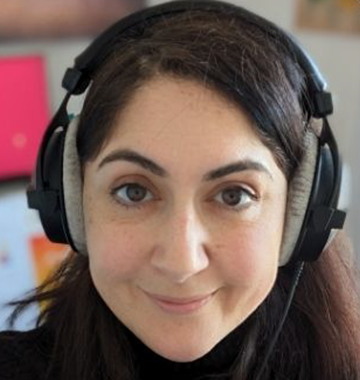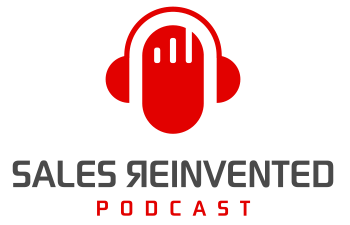Episode #420: Simone Laraway

Meet
Simone Laraway
Simone Laraway is a new business consultant, vocal health coach and author of The Holistic Guide to Cold-Calling. She has been on the phone nattering away building new business pipelines for multiple clients across the B2b Marketing Services industry for over 20 years.
Our Mission Is To Change The Negative Perception Of Sales People
Our Vision Is A World Where Selling Is A Profession To Be Proud Of
Cold-calling is an opportunity to plant seeds that you can nurture. It allows you to build meaningful new business relationships. Simone Laraway believes that as long as it’s part of a wider campaign, it’s still incredibly relevant.
But how do you approach cold-calling? What makes it more effective? Simone shares her strategies in this episode of Sales Reinvented.
Outline of This Episode
- [0:52] What is cold-calling? Is it still relevant?
- [1:46] Is cold-calling an art and a science?
- [2:55] How Simone prepares for cold-calling
- [5:16] Simone’s opening lines and techniques
- [6:14] How to keep a cold call engaging
- [7:42] Tools, technology, and metrics
- [10:22] Simone’s top cold-calling dos and don’ts
- [12:58] How Simone handles objections and rejections
How Simone prepares for cold-calling
As a voice coach, Simone believes that the voice is an often overlooked tool when it comes to cold-calling. A good voice resonates with people. So Simone does a warm-up exercise she calls “voice gym.” She also looks at her posture and makes sure she’s sitting in a good position.
She has her database open, script at hand, and email template ready (so if someone wants more information she can send it). She mentally prepares by thinking, “I’m going to have a great day. I’m going to have great conversations. At the end of the day, I’m going to feel good about myself.”
She makes sure her work environment is quiet and all distractions are removed. She always has a small piece of paper so she can draw or scribble if she’s on hold. Then she dives in.
Simone’s approach to cold-calling
Simone is all about getting straight to the point. She’ll say who she is, why she’s calling, what her company does, and ask a question.
Keeping a cold call engaging depends on the person who answers. You have to listen. If someone sounds rushed and it feels like you’re the last person they want to speak to, Simone may say, “I hear that you’re busy. Is now a good time? If they say no, she’ll say “I’ll call you another time when it’s more convenient.”
If she gets into a conversation, she’ll use the research she’s done to speak to their pain points. She’ll ask any questions that get them talking for longer. It’s all about what they want and need.
Simone’s top cold-calling dos and don’ts
What does Simone do to be effective?
- Warm up your voice. Get your voice how you want it so you feel confident. Too many people aren’t comfortable with the sound of their voice.
- Love why you’re calling. Sincerity can be heard in the voice. Be genuine. Because Simone guarantees that the person you’re speaking to will hear it.
- Get yourself in the zone. Do your homework and be mentally prepared.
- Don’t call when you’re distracted. Set apart cold-calling time and don’t let anyone interrupt you.
- Don’t get hung up on a bad conversation. Let go of that energy. If it’s pulled you down, move around, grab a cup of tea, and get back to work.
- Don’t talk too much. Don’t talk over people. If someone says “No,” don’t say “Yes, but…” Give them room to speak.
Remember, the call is about them.
How Simone handles objections and rejections
Cold-calling is a marathon. You get more than one chance to overcome objections. Objections are an opportunity to learn more about the person or company. If someone says, “No,” Simone doesn’t try to change their mind. However, she does want to find out why it’s a no.
She’ll regroup and reach out to colleagues to see if they have any ideas. She may email or reach out through different channels. She’ll call again at a later time with a different or more tailored approach.
She spoke to a Brand Director who was happy with their packaging. 18 months later—after 10 calls, emails, and comments on their LinkedIn page—she got the company to agree to a pitch. Her client won the rebrand. But it took time. Don’t let someone’s first no be the final answer.
Resources & People Mentioned
Connect with Simone Laraway
Connect With Paul Watts
Audio Production and Show notes by
PODCAST FAST TRACK
https://www.podcastfasttrack.com
Learn More About Simone Laraway
What was a pivotal moment or experience in your career that shaped your approach to cold calling, and how did it change your perspective or strategy?
In the early days of my cold-calling, I simply got on the phone, read my script, had my goal in mind and didn’t really think too much about the person I was calling. However, one day, I made a call and spoke to an MD who listened to my opening gambit and then replied, saying, “That sounds really interesting, but unfortunately, I’m actually in Labour, so now’s not a good time.” My script got abandoned, and we just started chatting. She packed her bag and got ready to head off to the hospital. It was a wonderfully “human” moment that shifted the way I view calls to make it about the person you’re calling, not targets or lists of numbers.
Can you share a specific tactic or approach you’ve used in cold calling that significantly increased your success rate? Please provide a brief example or case study.
I help companies in crafting their narrative, ensuring the initial moments of a call resonate with the recipient. It’s crucial to convey who you are, what you do, and the purpose of your call. With limited time, it’s beneficial to refine your opening lines to sound natural and unforced. I collaborated with a design firm that struggled to differentiate itself and establish a cold-calling campaign due to their inability to articulate their own story. They were great at doing this for their own clients but couldn’t do it for themselves. Together, we brainstormed, delved into their history, and identified their passion for their design approach and client service. We formulated their message and devised an opening strategy for calls, integrating this with sector-specific events and LinkedIn networking. Within two months, they secured a client and developed a healthy pipeline of opportunities.
Cold calling often comes with its set of challenges and rejections. Can you share a particularly tough challenge you faced while cold calling and how you overcame it?
I don’t focus on the challenges and rejections. Instead of thinking, “I’ve been rejected”, I think, “What information can I glean here?”. I break down responses into Yes, Maybe and No. I obviously want Yes, I want to nurture the maybe’s and the No’s I want to know why it is a no and can thatresponse potentially become a maybe? I now train people to become cold-callers and the challenge I face is teaching patience, that creating new business through cold-calling can really take a very long time. So I teach that to overcome the challenges you don’t fixate on the ones who said no, but simply revisit them in 6 months/ a year etc. I teach that companies change, people move roles, budgets and focus shifts, so it’s your job as a cold-caller to simply be solid and stead and call back when you say you will. Just keen chipping away.
What are the top three tools or resources (e.g., software, books, training programs) you consider essential for someone looking to improve their cold calling skills and outcomes?
Not to be cheeky, but I wrote a book called “The Holistic Guide To Cold-Calling” which is a step-by-step guide to getting you on the phone and creating new business opportunities. Being totally biased, I recommend my book to anyone who wants a straightforward approach. I highly recommend a CRM – I use the Less Annoying CRM – www.lessannoyingcrm.com/invite/AF713, which is just brilliant for organising your data and keeping on top of your leads. I also recommend a headset; voice, posture and neck health are vital for cold calls and are often overlooked. Your voice is a vital tool.
How do you foresee the practice of cold calling evolving in the next few years with advancements in technology and changes in buyer behaviour? What advice would you give to sales professionals to stay ahead of the curve?
Cold calling, despite its challenges with hybrid working and getting through to people, will remain a relevant sales practice. With AI, we can do more research into behaviours, and that can help with research and preparation for the calls. To Future-proof your cold-calling efforts, stay updated on tools such as CRM systems and call analytics, and don’t rely solely on cold-calling. See cold-calling as part of a wider approach to outreach. Cold Calling is about planting seeds and nurturing relationships, and remember that making that human connection is still invaluable.
Share This Episode, Choose Your Platform!
